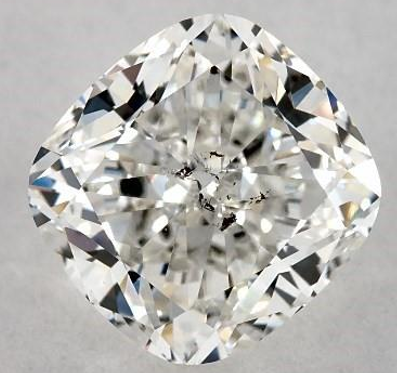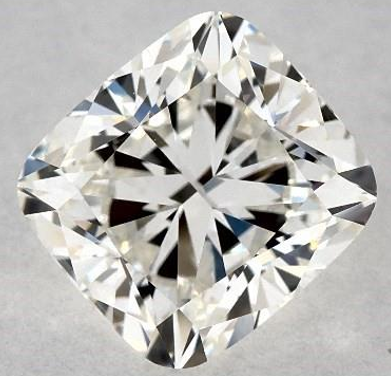This article has mentions of products from one or more companies, and I may receive compensation if you purchase those products following reading my recommendations.
If you are looking for a diamond with modern brilliance but a rich history of adoration, look no further than a cushion cut. Conjuring sparkling images of 19th-century royalty with diamond adorned hands twinkling in soft candlelight, the cushion cut reigned as the most popular choice of diamond cut for over 200 hundred years. Modern bridal trends may favor the round brilliant, but there will always be a special place for this long-cherished stone.
You may hear the cushion cut referred to as a ‘pillow cut’ or ‘candlelight cut’. The appearance of a cushion cut is rectangular or square, with soft rounded corners and a ‘pillowy’ look. Originally, the large facets and heavy areas of light and dark were perfect for reflecting the candlelight and gas lamps of bygone times. The cushion cut we see today has undergone dramatic changes and modernization to improve light performance, but the unique, soft shape still remains.
The cushion cut is a predecessor of the old mine cut. At a time when diamonds were ground and cut laboriously by hand and measured by eye, there was little to no consistency from diamond to diamond. The early cutters simply followed the octahedral shape of the rough diamond creating a squarish shape with 58 facets.
Although a modern cushion cut is now the product of technological advances, this idea of each diamond having its own ‘personality’ remains true; there are many variations of facet patterning that can be used in a cushion cut and each of these facet plots will give a different look to the diamond.
As stunning as it is historic; if you are looking for a cushion cut diamond, I have completed this guide to assist you in finding a stunning example of this often-misunderstood stone.
For the highest cut quality round brilliant and princess cut diamonds, make sure you take a look at Whiteflash and their A CUT ABOVE Diamonds®, for Fancy Cut Diamonds look at what James Allen can offer you.
Types of Cushion Cut Diamond
I am often asked to help buyers navigate the complex world of cushion cut diamonds. You will hear a host of terms referring to both the cut and the appearance of the diamond, such as crushed ice, chunky cushions, antique, modified cushions, classic cushions, broken glass, large culet, no culet, and modified cushion brilliants.
The good news is that while the terminology is vast, the distinctions between the types of cushion cut diamond are generally quite easily spotted (or make no difference to the appearance at all).
The better news still, is that it ultimately deciding between these variations comes down to personal preference and taste!
Standard Cut VS Modified Brilliant Cut

The differences between a standard cushion cut and a modified cut come down to technicalities. It is an example of a difference in cushion cut with minimal effect on the appearance of the stone. It is ultimately a matter of history; a standard cut uses traditional cutting styles, while a modified brilliant are variations on the original facet patterning. The two standards were set by the GIA so that the facet patterning could be assessed independently.
One of the biggest misconceptions regarding cushion cut diamonds is that opting for a standard cut will give a ‘chunky’ look, while selecting a modified brilliant cut will give the ‘crushed ice’ appearance.
Do not be misled. These technical differences between these cuts will not have a significant impact on the appearance of the stone. A diamond certification will never specify whether a diamond has a crushed ice or a chunky appearance. Therefore, it is essential that you familiarize yourself with the appearance, determine your preference and view any diamonds through high-res imaging or by eye.
Chunky/Antique Cushion Cut

Much like a round brilliant, a cushion cut that is described as chunky or antique will have a clear faceting pattern when looking into the table of the stone. You can see distinct areas of light and dark and a semblance of a defined pattern.
Crushed Ice Cushion Cut

When looking into the table of a crushed ice cushion cut, there is no defined facet patterning. The chaotic sparkle is similar to the effect seen in a radiant cut diamond.
Getting the best from your cushion cut diamond is all about focusing on the 4 Cs. Do not get distracted by the various branches and terminology adopted in sales and marketing campaigns, or even by the small technical differences between the cuts. It is all about finding the appearance that appeals the most and getting the best quality possible.
Choosing the Best Cushion Cut Diamond
Like all diamonds, choosing the best cushion cut diamond is all about getting the best possible quality for the best possible price. If you combine this with your personal preference for appearance and a world-class certification (such as GIA or AGS), you are guaranteed a stunning diamond.
Cut
Unlike other cuts, there are some fairly broad parameters when it comes to the cut specifications of a cushion cut diamond. I have outlined the typically desired proportions; however, I would suggest using these as a guideline in conjunction with my tips for the other 4 Cs.
Table % - 61-67
Depth % - 61-67
Cutlet – None/Very Small
Polish/Symmetry – Very Good/Excellent
Length to Width Ratio – Cushion cuts can be square or rectangular so there are no ‘ideal’ ratios. It may, however, give some indication as to how big the diamond will look on the hand.
The difficulty with these specifications is a cushion cut diamond has soft corners and can be square or rectangular. Some people prefers very soft, rounded corners and a squarer shape, while others prefer less rounded corners and a more elongated shape.
Once again, I must, again, stress the importance of viewing any potential diamonds and establishing your preferences before making your final decision.
Color
The cushion cut and radiant cut are both used when cutting fancy colored gemstones as they tend to emphasize color. This is great news if you are looking for an intense, fancy colored diamond, however if you are looking for a traditional, colorless diamond for your engagement ring you will need to remember that choosing your color grade with care is an essential part of getting the most from your diamond. They do not mask color as effectively as a round brilliant, for example, but moving just one or two grades higher can have a huge impact on the value and beauty of your stone.
I would recommend a G-H in color for the best appearance. The difference between the two grades will be almost imperceptible to the naked eye, so if you are working to a set budget, remember that an H will absolutely look colorless. Some people are naturally more specific on color, and in this instance I recommend a G. Both grades fall into the GIA subcategory of ‘near-colorless’ and will result in a stunning diamond.
If you are choosing a yellow or rose gold setting, there is a little more flexibility within the color grades, and an I-J would also be suitable and appear colorless.
A G color grade would be the maximum I would go to for a cushion cut diamond; anything beyond this will be spending money for a difference that you simply will not see.
Clarity
One of the distinctive features of the cushion cut diamond is the large, open table. This, combined with the rounded edges, means that these diamonds can be a little less forgiving when it comes to concealing the appearance of inclusions.
Nevertheless, I would advise starting your search at an SI1:


Both of these modified cushion-cut diamonds from James Allen are graded as an SI1 and have both been photographed at a 20x magnification. The diamond on the left has some heavy inclusions located in the table which diminish sparkle and beauty. By contrast, the diamond on the right is beautifully clear.
This demonstrates the importance of viewing a diamond in the best conditions possible. Two diamonds with the same clarity grading can look very different, depending on the position of the inclusions.
Although certification is essential, do not rely solely on the diamond clarity grading. A VS2 will cost a great deal more than an SI1 but can still have an unfortunately positioned inclusion. Trust your eyes.
And Finally…
A vintage beauty, a historical favorite, and a modern masterpiece; the cushion cut diamond has transcended eras and continues to be a beautiful choice for an engagement ring. As always, certification from either of the internationally respect gem labs (GIA or AGS) is a must when looking for a quality diamond.
A cushion cut diamond simply must be seen; I would recommend starting your search on Blue Nile or James Allen who both offer the highest quality photographs and largest inventories available. Build an idea of your perfect diamond; the softness of the corners, the crushed ice or chunky appearance, whether you prefer a squarer or more rectangular shape. From here you can use these guidelines to find the diamond of your dreams.
Whether it’s the softness of candlelight or streaming sunlight, a well-chosen cushion cut will turn heads and dazzle for decades to come.
